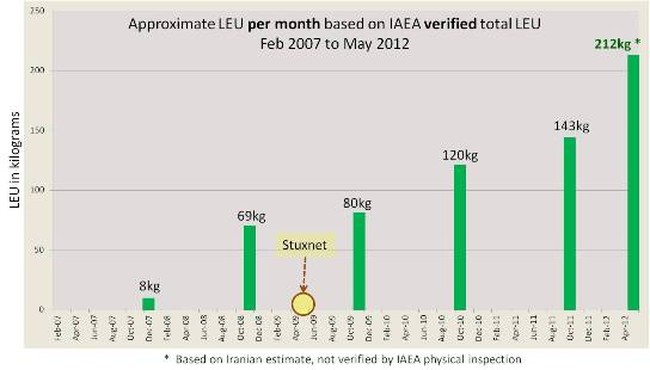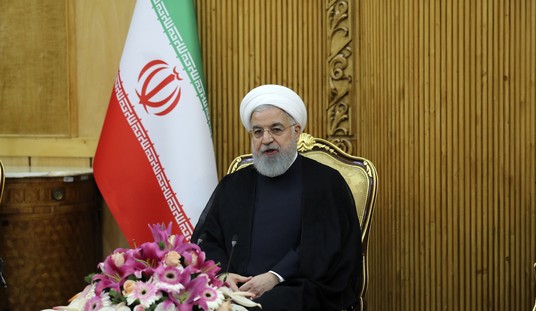[Only Graph 2 is reproduced with this post. To view both graphs, see this piece at The Optimistic Conservative.]
The flood of recent disclosures about President Obama’s actions in the national security realm has the infosphere abuzz with soundbites like “playing cards” (decorated with terrorist photos, which the president reportedly uses to select drone victims), “Flame,” and that new-old standby, “Stuxnet.” Some conservatives, in particular, are spending time pointing out that the Stuxnet effort was launched by the Bush administration, that “Flame” apparently was too, and that using the playing cards to pick drone victims is just creepy.
I believe we could be doing better things with our time. I suggest that we let Obama take whatever credit he wants, and focus instead on the things that matter, such as what Iran is doing and why Stuxnet has been all kinds of fun, but hasn’t, on balance, done jack. Remember what Stuxnet was for: making centrifuges shut down. And it apparently did manage to make a number of centrifuges shut down. But it hasn’t slowed uranium enrichment. One more time: it hasn’t slowed uranium enrichment. It may at most have slowed the rate of acceleration in uranium enrichment. Stuxnet has had its day, and it didn’t put a significant crimp in Iran’s progress.
It’s nice to think there may be other lines of effort out there, things we haven’t heard about or that haven’t been implemented yet. But I’ll wait to see the usefulness of the effects first. Since Stuxnet was introduced, sometime in the spring of 2009, Iran’s overall rate of uranium enrichment has continued its acceleration.
A couple of graphs tell the tale. Graph 1 is a depiction of the total low-enriched uranium (LEU) produced since February 2007, when Iran began enriching uranium hexafluoride (UF6) on an industrial basis. The numbers are taken from the IAEA reports, which are available here (the latest report from 25 May 2012 is on the ISIS website).
The average monthly production represented by these figures is displayed in Graph 2. The averages are valid for the months prior to the date on which the average is given, which coincides with an IAEA physical inspection of Iran’s LEU stockpile.
In Graph 1, I have reflected marginal uncertainties in some of the LEU totals reported by IAEA (which obviously affect the average production rate). The IAEA reports describe the reason for these uncertainties, for those who are interested. The average production rate of 120kg per month between November 2009 and October 2010 may thus have been lower (and the previous rate higher), although probably not by much. In any case, with the exception of the most recent IAEA report (the 25 May 2012 document), I have used only totals that were verified by physical IAEA inspection.
How accurate they may be, if Iran is concealing activities, is another issue. Through October 2011, however, I have compared apples to apples, using IAEA data, to produce the graphs.

The purpose of these graphs is not to root out month-to-month differences in production rate, but to demonstrate the overall trend Iran is maintaining, which has been positive, with the rate increasing, at the physical inspection points since 2007.
Between October 2011 and May 2012 – if the Iranian-reported total is accurate (the totals have tended to be accurate or to slightly underreport production) – the average monthly LEU production rate between IAEA physical inspections (in this case, since the last inspection in October) has jumped to 212kg per month, or about a 40% increase in the average monthly rate over the previous period (143kg per month from October 2010-October 2011). The rate of increase had been significantly smaller in the two years prior to November 2011, but still no lower than 16%.
That period, November 2009-October 2011, was the one in which numerous Western media analyses suggested Iran’s production capability was badly damaged and faltering (see here as well). Perhaps elements of it were, but the reality is that it hasn’t mattered all that much. The rate of growth in the average monthly production rate slowed, but still remained positive. And it appears to have recovered.
The amount of LEU declared by Iran through May 2012 is enough to produce five nuclear warheads. But Iran is close to (or may have passed) a more significant milestone with the “medium-enriched” or reactor-grade uranium being enriched to approximately 20% purity. This effort was inaugurated in early 2010. Most of the known work has been going on at the Natanz Pilot Fuel Enrichment Plant (PFEP), but some work has occurred at the hardened, mountainside Fordo site near Qom, which President Obama announced our knowledge of in September 2009, and which Iran declared to the UN, got on the inspection regime, and began operating in 2011.
According to the 25 May IAEA report, Iran estimates having enriched a total of 145.6kg of uranium to 20% purity. Fordo has produced 36.4 of those kilograms; the balance were enriched at Natanz. If the Iranian self-reporting is correct, the program now has more than the 140kg of 20%-enriched uranium nominally required for a nuclear warhead. (This has not been physically verified yet. IAEA verified 73.7kg of 20%-enriched uranium in September 2011.)
Meanwhile, the report also states that traces of uranium enriched to 27% were detected at Fordo in February 2012. (See para. 28 of the 25 May report.) This suggests that Iran may have begun enriching uranium higher than 20%, which would indicate pursuit of a weapons application.
ISIS reported this month that new imagery of the special facility at Parchin shows suspect buildings being razed, along with other work (i.e., earth-moving) that appears related to sanitizing the site where there was formerly a nuclear-detonator testing facility. As the short-lived Baghdad talks opened in May, IAEA head Yukiya Amano suggested that negotiators were close to a deal with Iran – under discussion since February – to get inspectors to the Parchin site. It appears the Iranians are not yet satisfied with the results of their sanitization efforts, however, as the head of Iran’s atomic energy agency said five days later that he wasn’t convinced an inspection was necessary.
AP reported back in mid-May on information from a foreign official about the detonator-testing chamber reportedly set up at Parchin (apparently after 2000). The foreign official had a description from an Iranian source, which yielded a computer-generated drawing of the test chamber. According to a former IAEA official interviewed for the AP story, the drawing of the chamber was accurate and appeared to match a photo he had recently seen of the test chamber at Parchin. There is little doubt at this point that there was a detonator-testing chamber housed at Parchin, probably in the building ISIS reported on earlier this year. And as a reminder, the US provided the original intelligence on a probable detonator test by Iran in 2004.
No reason to take our eyes off the ball here. Iran continues to make progress toward nuclear weapons, and attempt to throw the wool over Western eyes. It seems to be working. How often do you hear from the MSM about Iran’s progress, as opposed to what President Obama is doing about the problem?
J.E. Dyer’s articles have appeared at The Green Room, Commentary’s “contentions,” Patheos, The Weekly Standard online, and her own blog, The Optimistic Conservative.
This post was promoted from GreenRoom to HotAir.com.
To see the comments on the original post, look here.








Join the conversation as a VIP Member